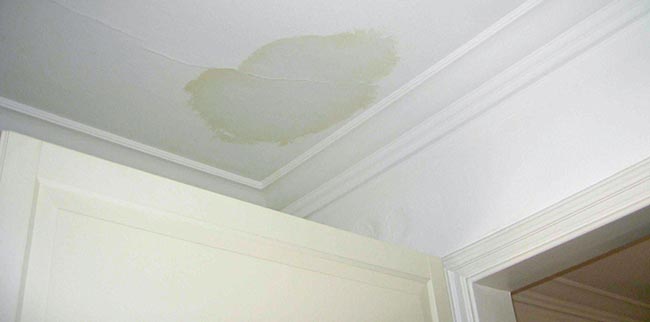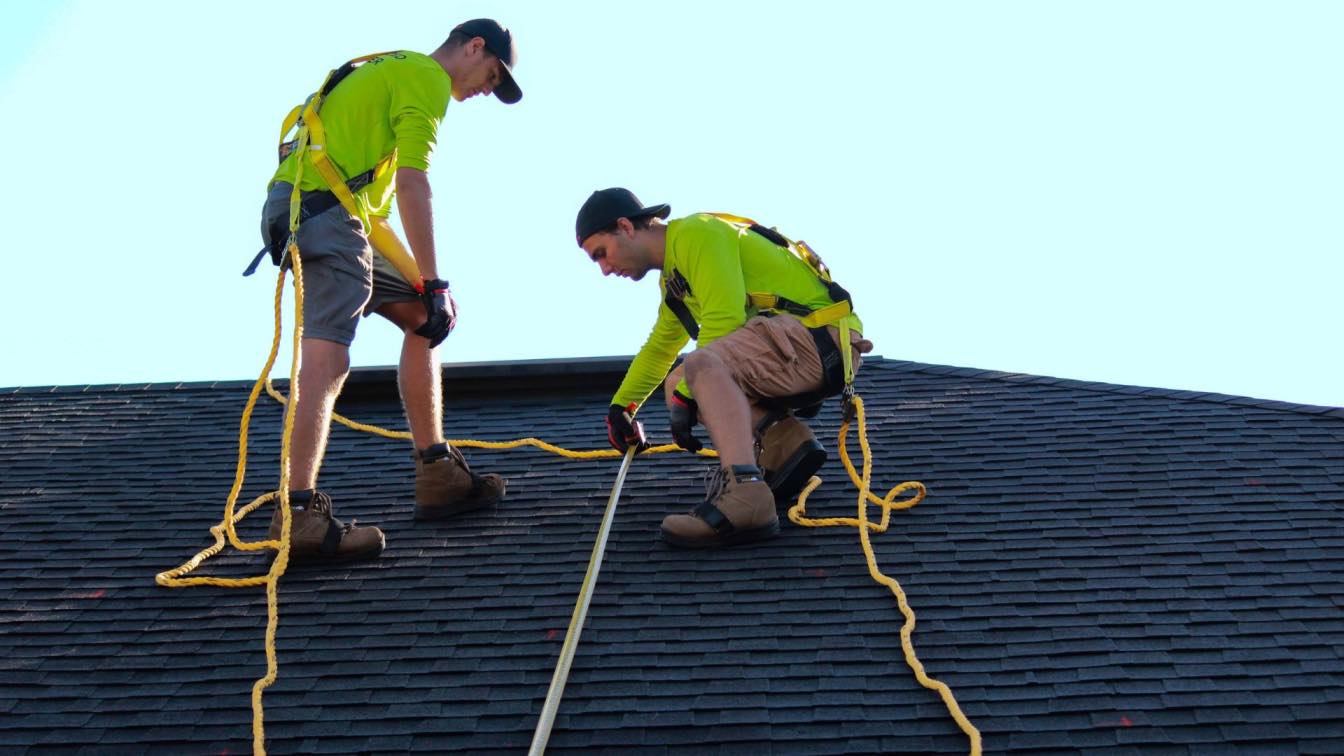Early signs of roof deck damage include sagging ceilings and water stains. Detecting dampness or mold growth can also indicate an underlying issue.
Remaining aware of the condition of your roof is vital in maintaining your home’s structural integrity. Spotting early signs of damage to your roof’s decking is imperative to prevent more extensive and expensive repairs. As a homeowner, you should regularly check for indicators such as leaks, peculiar sounds, or visible wear and tear.
A well-maintained roof is essential for the overall health of your property, ensuring protection from the elements and averting potential damage to your interior living spaces. Observing these signs promptly can lead to early interventions, making repairs more manageable and less costly while extending the lifespan of your roof.
Recognizing Roof Deck Deterioration
Your roof deck is the foundation upon which your shingles and other roofing materials rest. It is crucial to maintaining the integrity of your entire roofing system. Identifying early signs of roof deck damage can save you from costly repairs and extend the life of your roof. In this section, we’ll explore how to spot those early indications of trouble before they lead to larger issues.
Importance Of Early Detection
Recognizing deterioration early on can mean the difference between a minor repair and a major overhaul. Regular inspections allow for timely interventions, which can prevent damage from spreading to other parts of your house, such as the attic or interior ceilings. Key indicators include:
- Sagging or warped areas on the roof
- Signs of water damage such as staining or mold
- Light coming through the roof in the attic
- Loose material or wear around roof penetrations
Consequences Of Ignoring Early Signs
Failing to address early signs of roof deck deterioration can lead to severe problems. Moisture damage not only affects the roof structure but can also encourage mold growth, which poses health risks. Ignoring these signs often results in:
| Consequence | Detail |
|---|---|
| Structural Damage | Compromised integrity of rafters and joists, leading to potential roof collapse. |
| Increased Repair Costs | More extensive damage requiring larger financial investment. |
| Insulation Damage | Wet insulation reduces energy efficiency, increasing heating and cooling costs. |
In sum, staying vigilant about the condition of your roof deck is essential. Regular checks enable you to catch issues early and avert potentially disastrous outcomes. It’s always a smart move to engage a professional roofer for an in-depth inspection if you notice any concerning signs.
Spot Early Roof Deck Damage Signs
Your home’s rooftop is its primary shield against the elements, a silent guardian to your comfort and safety. But what happens when the integrity of your roof deck begins to falter, hidden from plain sight? Early detection of roof deck damage is not just a matter of home maintenance—it’s about preserving the sanctuary that is your home. Let’s delve into the telltale signs that your roof deck may need some attention.
Discoloration And Water Stains
One of the first indicators of a compromised roof deck is visible discoloration and water stains. These unsightly blemishes can reveal themselves on your ceilings or walls and are often the result of prolonged water exposure. The situation merits swift action; here’s what to keep an eye out for:
- Yellowish or brownish circles on the ceiling
- Streaks running down interior walls
- Peeling paint or wallpaper near the ceiling
These visual clues suggest water is infiltrating and damaging your roof deck from above, marking critical areas for further inspection.
Warping Or Buckling Of The Deck
As you conduct your investigation, be mindful of the roof deck’s physical condition. Warping or buckling of the plywood or lumber used in the deck can signal underlying issues. This can manifest in several ways:
- Curvature or distortion in the lines of the roof when viewed from the ground
- A bouncy or spongy feel underfoot when traversing the roof
- Visible gaps between the deck and roof supports
These symptoms require immediate attention to prevent further structural damage or possible roof collapse.
Growth Of Mold Or Mildew
Lastly, the unwelcome presence of mold or mildew can often accompany moisture-related roof deck issues. Mold thrives in damp conditions and can affect both the exterior and interior of your home, with signs including:
| Location | Signs of Mold/Mildew |
|---|---|
| Exterior | Black or greenish streaks and spots, especially in shaded areas |
| Interior | Musty odors, visible growth on attic sheathing or rafters |
Do not underestimate these signs; mold and mildew can degrade your roof further and pose health risks to inhabitants.
Attentiveness to these early signs can lead to prompt repairs that preserve your roof deck’s longevity and ensure your home remains a safe haven.
Inspecting Shingles For Warning Clues
Identifying early warning signs of roof deck damage is crucial to prevent costly repairs. The shingles on your roof provide tell-tale signs that are visible to the naked eye. Regular inspection and understanding what to look for can save homeowners from more extensive damage. Below, we delve into certain shingle conditions that alert you to potential roof deck issues.
Missing, Broken, Or Curling Shingles
Shingles are the first line of defense against the elements and should remain intact. Missing or broken shingles create vulnerabilities, exposing your roof deck to water damage and decay. Similarly, curling shingles, which may lift and fail to protect the roof adequately, are often a sign of age or excessive heat. Conduct a visual inspection after severe weather and seasonally to catch these issues early.
Granule Loss On Shingles
Your shingles’ granules play a critical role in protecting your roof from sun and rain. When you start noticing granule loss, which can appear as bare spots or a significant accumulation in your gutters, this indicates your shingles are aging or deteriorating. Minor granule loss over time is normal, but sudden or uneven loss suggests potential roof deck damage.
Table showing signs and possible reasons| Sign | Possible Reason | Action Required |
|---|---|---|
| Missing Shingles | Weather Damage or Poor Installation | Inspect and Replace |
| Broken Shingles | Physical Impact or Brittle Materials | Evaluate and Repair |
| Curling Shingles | Aging or Heat Damage | Assess and Possibly Replace |
| Granule Loss | Age or Defective Shingles | Monitor or Consult a Professional |
- Perform regular roof inspections, especially after severe storms.
- Watch for shingle debris in gutters or downspouts as a sign of potential problems.
- Look for any patterns of loss or damage that could indicate a broader issue.

Credit: bobbehrendsroofing.com
Assess Your Attic
Your home’s defense against the elements starts with the roof, and the integrity of your roof deck is a critical component. Assessing your attic can reveal a lot about the condition of your roof before problems become visually apparent from the outside. Spotting early signs of roof deck damage can save you from costly repairs down the line.
Checking For Light Penetration
A clear method to gauge the health of your roof deck is by looking for light penetration. Even the smallest shaft of light coming through the roof can be a telltale sign of potential vulnerabilities. Here’s how you can perform a simple check:
- Choose a sunny day and switch off all lights in the attic.
- Inspect the underside of the roof deck carefully.
- Note any areas where light penetrates — these are spots where the roof may be compromised.
Remember, areas that allow light to enter may also let in water, thus they demand immediate attention.
Signs Of Moisture Or Water Damage
Moisture is your roof’s nemesis and spotting it early is crucial for avoiding a more serious problem. When inside your attic, keep an eye out for the following indicators of moisture or water damage:
- Dampness or stains on the wood
- Presence of mold or mildew
- Warped or softened wood
- Corrosion around roofing nails
Be sure to examine areas around vents, chimneys, and where the roof deck meets the walls. If you find any signs of moisture, it’s essential to identify the source promptly and initiate repairs.
Preventative Measures And Maintenance
Preventative measures and maintenance are crucial for extending the lifespan of your roof and ensuring the safety of your home. By taking proactive steps to care for your roof, you not only safeguard against severe weather conditions but also detect any early signs of roof deck damage before they escalate into costly repairs. Consistent upkeep and attention can circumvent the need for a premature roof replacement. To secure the longevity of your roof, integrate regular roof inspections and promptly address minor issues as part of your routine maintenance.
Regular Roof Inspections
Conducting regular roof inspections is paramount in identifying and mitigating potential problems early on. It’s recommended to schedule an inspection at least twice a year, in the spring and fall, as well as after any severe weather events. Trained eyes will spot the following early signs of damage:
- Cracked, curled, or missing shingles
- Rust spots or cracked caulk on flashing
- Sagging or wear around vents, pipes, and chimneys
- Signs of water damage or leaks in the attic
- Peeling paint under roof overhangs
Keep records of these inspections to track changes over time, which can be pivotal in recognizing patterns of wear.
Promptly Addressing Minor Issues
When minor issues arise, addressing them promptly can be the difference between a simple repair and a full-blown, expensive roof project. Even small concerns like a single damaged shingle or a minor leak should be rectified immediately to prevent water intrusion and further damage. Here’s what you should do:
- Replace damaged or missing shingles as soon as possible.
- Reapply caulk or sealant to areas showing signs of wear.
- Clean gutters and downspouts regularly to prevent water buildup.
- Remove overhanging tree limbs that may damage the roof in a storm.
Keep in mind that minor repairs can be a DIY task; however, for more complicated issues, it’s wise to hire a professional roofing contractor to ensure the job is done correctly and safely.
Frequently Asked Questions Of How To Spot Early Signs Of Roof Deck Damage
What Are Common Signs Of Roof Deck Damage?
Roof deck damage often manifests as sagging or uneven roof lines. Water stains on ceilings or walls beneath the roof can also indicate underlying deck damage. Additionally, missing or damaged shingles can expose the roof deck to further harm.
How Can Weather Affect Your Roof Decking?
Extreme weather conditions, such as heavy rain, snow, and high winds, can compromise the integrity of your roof decking. Prolonged exposure to these elements can lead to moisture intrusion, which may cause rotting, mold, and structural weakness in the decking.
Why Is Early Detection Of Roof Damage Crucial?
Detecting roof damage early can prevent more extensive and costly repairs. It helps maintain the structural stability of your home and ensures that your roof continues to properly protect your dwelling from environmental elements.
Can A Damaged Roof Deck Lead To Leaks?
Yes, a damaged roof deck can definitely lead to leaks. If the decking is compromised by rot or physical damage, it can allow water to seep through to your home’s interior, causing damage to ceilings, walls, and possessions.
Conclusion
Being proactive with roof maintenance can save you time and money. Spotting early signs of deck damage is key. Remember to check for water stains, sagging, and daylight through the roof boards. If you notice any of these issues, act quickly to prevent further harm.
Secure your home’s integrity by staying vigilant about roof health.

